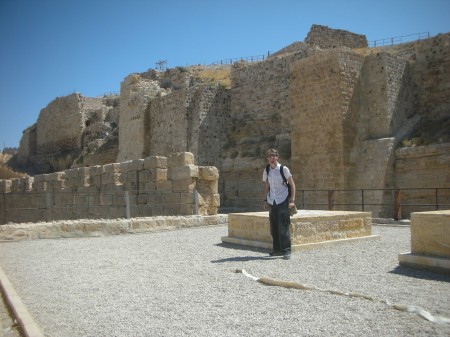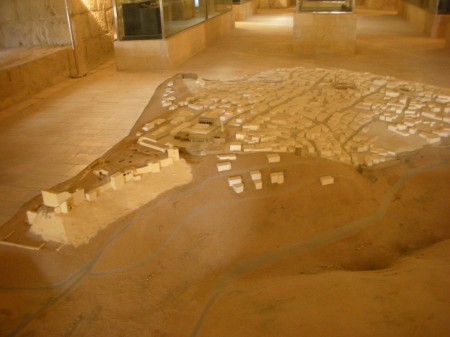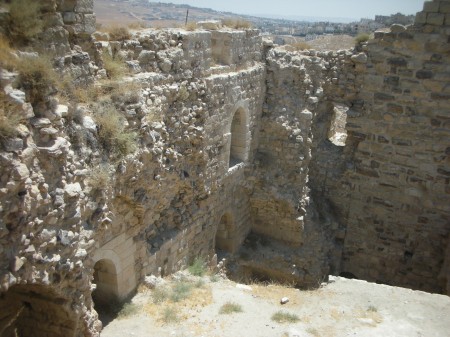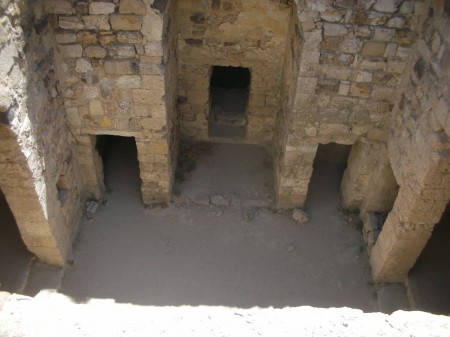Time is running out for me to see all the parts of Jordan that for whatever reason, I’ve missed out on over the past two years. The wheels lift on my outgoing plane exactly three weeks from today, so I started off my last month by doing not one, but two trips outside of Amman to some of Jordan’s beauties, first to Karak Castle, an ancient and well preserved Crusader castle in the south, and then to Wadi Himara, a scenic semi-tropical valley that feeds into the Dead Sea, and is home to the two largest waterfalls in the entire country. I’ll be writing about Wadi Himara and my upcoming trip to Wadi Ibn Hammad next week.

I'm standing on the remains of the south-western guard tower, with the walls of the High Court behind me
Both of the trips were hastily planned – in fact, I had forgotten about Karak Castle for at least a year until a friend from New Zealand that I met in Nazareth last month, and then again in Amman several weeks later, mentioned that he had visited it. Hearing stories about his casual trips around the area, without even knowing either Semitic language, made me remember that I could certainly navigate Jordan’s cheap and plentiful bus system, especially to a relatively large city like Karak.
What I didn’t count on was how long I’d spend waiting for buses! The combination of it being early, being the Friday holy day, and Ramadan fasting having started on the 10th, meant that I almost spent as much time waiting for buses to leave, as sight-seeing! Notice that I say waiting to leave, as opposed to arrive. Not for the first time, I’ve realized that the reason why a two hour, 90-km journey from Amman to Karak costs less than $2.50 is because they will simply refuse to leave the bus stop if they’re not at 95% capacity – at least! When I pay $50 for a one-way ticket from Beloit to Chicago O’Hare, I’m paying for all those empty seats, too. Money is one thing that most bus-riding Jordanians do not have a lot of…but time to burn, waiting in these dark, musty buses, is plentiful.
I arrived at Karak at 9:30 AM, having left my home at 7. My neighbor Marwan warned me to get to the bus early, because there might not be a second one ‘til the afternoon! He was almost certainly correct – I shudder in sympathy to think of the poor souls who arrived at the station mere moments after we left at 8:15 – the driver estimated nonchalantly to me that between empty and departure, he’d been waiting for passengers for almost three hours.
It amuses me to think that the first and only previous time I’d been in Karak was over two and a half months ago, when our band of eight foreigners passed through briefly on our way to Wadi Hasa. I remember drowsily wondering where the famous castle was in the quiet city, and then getting distracted by something else. We stopped at the same station, and the driver pointed up…and up…to where worn stones palely shimmered in the morning light. The castle had been directly above my head some 150 meters, had I bothered to look up! Download this Google Earth KMZ file to see Karak from my perspective.
I strolled leisurely up the quiet hill, listening to the sound of sheep calling to each other in the valleys surrounding the city. The call to prayer had been hours ago, and the next one would be in another few hours. During these sleepy times when no smoking, eating, or drinking were allowed, many Muslims stay indoors as much as possible, parked in front of fans and trying to keep as much moisture and calories within. I saw some laborers building a shed in the shade of a taller apartment, looking like it was about to topple off of the edge of the hill, and caught the slightly nasal-sounding accent of Egyptian slang. It seems that nothing keeps them from working, Ramadan or not!
The admission was only a single dinar, the same as what my guidebook from 2006 told me. The ticket seller informed me that in his twenty years of working in Karak, he’d never heard a foreigner speak such good Arabic, to which I replied “praise God for curing your deafness,” but I probably messed up the wording on this complicated phrase and I don’t think he caught the joke. I promised myself I’d write it in the blog later so at least someone would.
For my first few hours in the castle, it was only me, the twittering birds, and a few grumpy-looking old Bedouins who looked as if they’d rather be sleeping instead of adding to the castle’s authenticity as a post-Crusader outpost. Apparently, after the glorious Salah al-Din (better known as Saladin to us Westerners) conquered the castle in 1187, it was re-used by governors and even by visiting Sultans during the Mamluk period. The more I read about the chivalrous and noble Kurdish warrior whose name means “the Righteousness of the Faith,” the more I’m impressed by him and his impeccable manners and character, especially compared to how embarrassing underhanded and foul the European invaders often were. In fact, it was the overseer of Karak Castle, the traitorous and sadistic Reynaulds, that earned Salah’s greatest ire by violating a treaty and attacking peaceful caravans trying to pilgrimage to Mecca, and after the castle’s capitulation, Salah personally decapitated the Frenchman – the only time in the Crusades that the Islamic leader executed a surrendered foe. Legend says that several years earlier, during a failed assault of the castle by Muslim forces, Reynauld’s heir was celebrating his wedding night in one of the towers, and after Salah inquired as to which tower contained the nuptials, he forbade his men to attack it.

This 2x2 meter model of Karak and its high-ground castle are prominently featured in the small museum
The wedge-shaped castle is situated on the southernmost corner of the fan-shaped city, and after walking all around it, both inside and out, I could see why attack was almost impossible with medieval weaponry and a patient siege was the only way that the Arabs eventually won. Arrow slits line every wall, and the small but tidy museum inside the castle walls showed pictures of the various defensive weaponry the Crusaders had at their disposal. After making the rounds through the museum and around the “lower court,” I went up some steps to the castle’s “high court,” a long, dusty plateau on which I could still see the lumpy remains of rocks and air pipes into the warrens below. Those rooms themselves were as dusty, dim, and rough-looking as I’m sure they were a millennium ago, and it was lucky that it was a sunny day or I probably would have been banging into more of the walls and possibly causing the whole structure to collapse on me. I could dimly make out ancient torch-niches on the walls, and sincerely wished they were still in use!
After climbing up to the high point of the Mamluk fortress on the southern edge of the castle, I called my friend from choir, Yanal, whose ancestors are originally from Karak. “Guess where I am?” I cheerfully told him as I looked out over his city. “My beautiful Karak!” he gasped to me over the phone. “If only you had told me you were going, I would have driven with you down there!” He extolled to me the virtues of Karak and Karaki people as proudly as ever, as I chuckled and agreed with him on every point.
I wasn’t alone all the time. As I was leaving the sunny stones of the high point of the Mamluk fortress on the southern edge of the castle, I came across a busload of Italian tourists who were loudly commenting on the place and chain-smoking; a forbidden activity during Ramadan which I’m sure didn’t do anything to improve the tourism Bedouins’ mood. I ducked down into the open-air court of the Mamluk palace under the defensive fortress quite literally – they had apparently been rather height-impaired sultans, and I whapped my forehead on the archway stones here several times – and examined the mosque and gathering rooms that the Sultan would have employed during his visits here from the Cairo capitol of the Mamluk empire in peacetime after the Crusades. Another advantage of these numerous hidden underground passageways is that I felt I could safely withdraw my hidden bottle of water and take a few quick drinks without being rude!
Before I left the castle, I found the tourist police chief in his office just inside the gate before the moat, and asked him about the mysterious “underground passageways” beneath the lower court that I’d read on a sign in the museum. That’s all locked up right now, he said. Well, is it possible to get the man with the key to open it for tourists? I asked. He looked at me like I was a little slow and gently reminded me that it was Friday afternoon in the first week of Ramadan. He’s probably home sleeping, like I wish I was, he snorted. So, I left satisfied that I had seen almost all of what was available in the castle, but of course as with all historic sites in the country, wishing that there were more signs and descriptions on placards throughout the building – there had only been four in the entire place outside of the museum. Most of the information which I’ve repeated for you here came from the two Jordan guidebooks I brought with me.

The mostly-crumbled north-western corner of the palace has had some fairly obvious reconstructions made...
I took a roundabout trip through the center of town to snap a few pictures of the bronze statue of Salah al-Din that sits in the square, and then meandered back down to the bus stop to play the waiting game again. It really is impossible to get lost in Karak; just keep walking until you are about to fall off a cliff, and then just walk around the hill! The waiting game this time around was in a large tour-sized bus, and it was for almost an hour and a half before we started the trek back to Amman. And when we returned, there was only an hour left before the evening’s Iftaar, or fast-breaking, and I knew I was lucky to find a taxi driver. A tall glass of ice cold water back at my apartment never tasted so good after a day of Ramadan touring, and there’ll hopefully be a lot more to come over the next few weeks!



No one has commented on this post - please leave me one, I love getting feedback!
Follow this post's comments, or leave a Trackback from your site